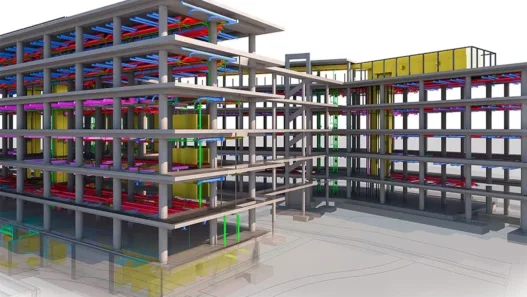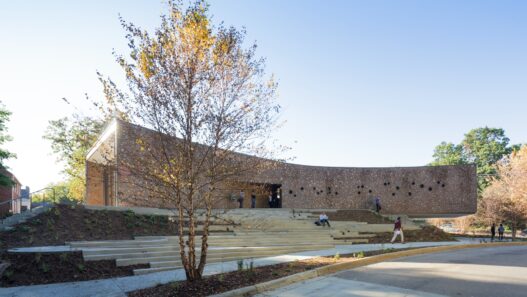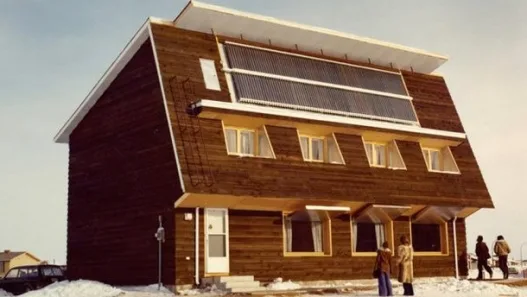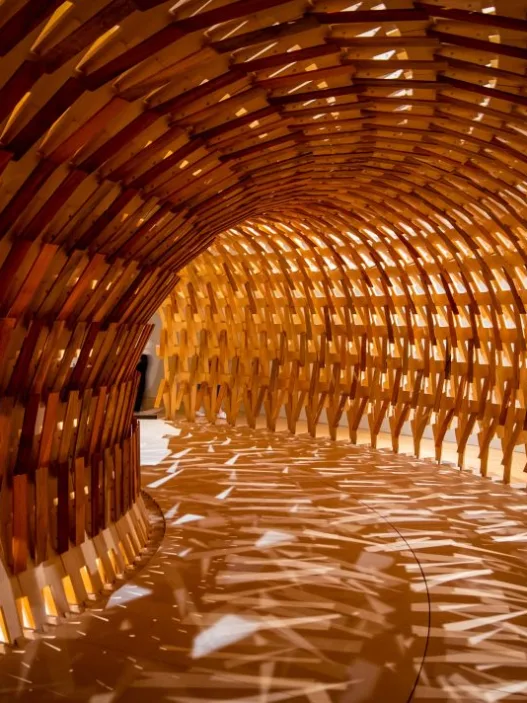Thermal mass is a fundamental concept in architecture and building design and refers to the ability of a material to absorb, store and release heat. This property plays a crucial role in regulating indoor temperatures, increasing energy efficiency and creating comfortable living environments. As we enter the world of thermal mass, we will describe its properties and materials, explore its historical context, examine its cultural significance in climate-sensitive design, understand its relationship with energy efficiency, and highlight global trends that recognize its importance in modern building practices.
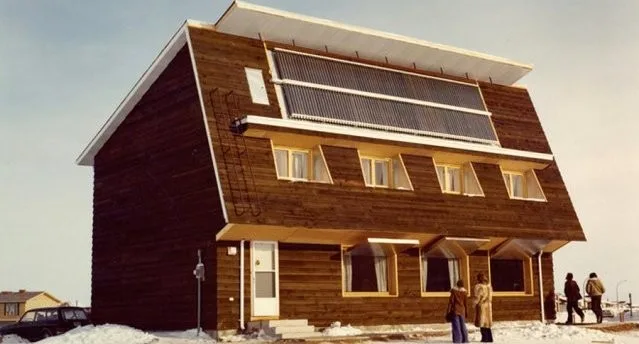
Defining Thermal Mass: Properties and Materials
Thermal mass is defined by the capacity of certain materials to absorb and retain heat energy. This property is primarily determined by the density, specific heat capacity and thermal conductivity of the material. High-density materials such as concrete, brick and stone are widely used because of their excellent thermal mass properties. These materials help to mitigate temperature fluctuations by absorbing heat during the day and then releasing that heat when the temperature drops, providing a more stable indoor environment.
The effectiveness of thermal mass is influenced by several factors such as the orientation of the building, the amount of sunlight it receives and the design of the space. For example, the strategic placement of thermal mass elements such as walls or floors in areas receiving direct sunlight can maximize heat absorption during the day and minimize heat loss at night.
In addition to traditional materials, modern innovations have led to the development of advanced thermal mass solutions, including phase change materials that can store and release heat more efficiently. These materials expand the possibilities of integrating thermal mass into contemporary building designs, improving energy performance and comfort.
Historical Context: Use of Thermal Mass in Traditional Architecture
The use of thermal mass is not a new concept; it has been used in traditional architecture for centuries. Ancient civilizations intuitively understood the benefits of using heavy, dense materials to create comfortable living spaces that responded to their local climate.
For example, in Mediterranean regions, thick stone walls were used to absorb heat throughout the day, keeping interiors cool in sweltering heat. Similarly, in desert environments, adobe structures utilized clay and soil to provide thermal mass, creating a cooler environment during the day and warmer at night. These historical examples illustrate how cultures have adapted their architectural practices to capitalize on the natural properties of materials, creating buildings that are both functional and sustainable.
As building technologies have evolved, thermal mass principles have continued to influence architectural design. The resurgence of interest in passive solar design in the 20th century further emphasized the importance of thermal mass in creating energy-efficient buildings that minimize dependence on mechanical heating and cooling systems.
Cultural Significance: The Role of Thermal Mass in Climate Responsive Design
Thermal mass has an important cultural significance in the context of climate-sensitive design. As societies become increasingly aware of the impacts of climate change and the need for sustainable building practices, the role of thermal mass in creating comfortable, energy-efficient spaces is gaining renewed attention.
In many cultures, traditional building practices that incorporate thermal mass reflect a deep understanding of local climates and environmental conditions. For example, in tropical regions, buildings are often designed with high thermal mass materials that help regulate indoor temperatures and provide comfort without the need for air conditioning. This cultural knowledge is invaluable in promoting sustainable practices that honor local traditions while addressing contemporary challenges.
Moreover, the integration of thermal mass into modern architecture can serve as a bridge between the past and the present, allowing architects to draw inspiration from traditional techniques while using modern materials and technologies. This approach not only enhances the aesthetic appeal of buildings, but also promotes a sense of cultural identity and continuity in the built environment.
Understanding the Relationship between Thermal Mass and Energy Efficiency
The relationship between thermal mass and energy efficiency is a critical aspect of sustainable building design. Buildings can reduce their energy consumption and minimize their environmental impact by effectively using thermal mass.
Thermal mass helps stabilize indoor temperatures, reducing the need for mechanical heating and cooling systems. During the day, thermal mass materials absorb excess heat, preventing interior spaces from overheating. At night, they release the stored heat, keeping interiors warm without the need for energy-intensive systems. This passive temperature regulation can provide significant energy savings, especially in climates with large temperature fluctuations between day and night.
Furthermore, incorporating thermal mass into building design can improve occupant comfort. A constant indoor temperature reduces the possibility of drafts and temperature fluctuations, creating a more pleasant living environment. This focus on comfort is in line with the growing demand for sustainable buildings that prioritize the well-being of building occupants.
Global Trends: Increasing Recognition of Thermal Mass in Modern Building Applications
In recent years, the importance of thermal mass in modern building practices has been increasingly recognized. As the construction industry shifts towards more sustainable approaches, architects and builders are increasingly incorporating thermal mass strategies into their designs.
This trend is evident in the rise of passive solar design principles that emphasize the use of thermal mass to optimize energy performance. Many contemporary buildings are designed with large thermal mass elements such as concrete floors and walls strategically placed to maximize heat absorption and retention.
Furthermore, advances in building materials and technologies have expanded the possibilities for integrating thermal mass into modern designs. Innovative products such as insulated concrete forms (ICFs) and prefabricated panels with increased thermal mass are making it easier for builders to incorporate effective thermal mass solutions into a wide range of projects.
As awareness of climate change and energy efficiency continues to grow, so will the acceptance of thermal mass as an important component of sustainable architecture. This shift will not only improve the performance of buildings, but also contribute to a more sustainable future for the built environment.
In conclusion, thermal mass is a vital concept in architecture, encompassing a wide range of features, materials and historical practices. Its importance in terms of climate-sensitive design, energy efficiency and cultural identity emphasize the enduring significance of this architectural element. As we move forward, the integration of thermal mass into modern building practices will play a crucial role in creating sustainable, comfortable and flexible environments that meet the challenges of our time.
Benefits of Thermal Mass in Energy Efficient Buildings
Thermal mass plays a crucial role in improving the energy efficiency of buildings and offers numerous benefits that contribute to a stable indoor environment, lower energy costs, improved occupant comfort and lower environmental impact. By understanding these benefits, architects, builders and homeowners can make informed decisions about incorporating thermal mass into their designs. This research will examine the main advantages of thermal mass such as temperature regulation, energy savings, comfort enhancement and environmental impact.
Temperature Regulation: Balancing Indoor Climate Fluctuations
One of the main benefits of thermal mass is that it regulates indoor temperatures, creating a stable climate in buildings. Materials with high thermal mass, such as concrete, brick and stone, absorb heat during the day when temperatures rise and release it during the cooler night hours. This process helps to moderate temperature fluctuations, preventing spaces from becoming too hot during the day or too cold at night.
By effectively managing heat transfer, thermal mass can significantly reduce reliance on mechanical heating and cooling systems. This balancing of indoor temperatures not only improves occupant comfort, but also contributes to energy efficiency by minimizing the need for artificial climate control. As a result, buildings with well-integrated thermal mass can provide a comfortable environment throughout the year, regardless of outdoor weather conditions.
Energy Savings: Reducing Heating and Cooling Costs
The energy saving potential of thermal mass is one of its most attractive benefits. By taking advantage of the natural properties of materials to regulate temperature, buildings can significantly reduce energy consumption for heating and cooling.
During the day, thermal mass absorbs excess heat, preventing the interior from overheating and reducing the need for air conditioning. At night, as temperatures drop, the stored heat is released, helping to maintain the temperature without the need for additional heating sources. This passive temperature regulation can lead to significant savings on energy bills, making thermal mass an economically viable option for energy-efficient buildings.
Furthermore, reduced reliance on mechanical systems not only lowers operating costs, but also reduces wear and tear on HVAC equipment, extending its lifespan and reducing maintenance costs. As energy costs continue to rise, the financial benefits of incorporating thermal mass into building design are becoming increasingly attractive to both homeowners and developers.
Comfort Improvement: Improving Indoor Air Quality and Occupant Comfort
Thermal mass contributes to occupant comfort in various ways by improving the overall indoor environment. Thermal mass creates a more pleasant living and working space by stabilizing temperatures and reducing fluctuations. This consistent temperature regulation minimizes drafts and hot spots, ensuring that all areas of a building are comfortable.
In addition to temperature stabilization, thermal mass can also improve indoor air quality. Buildings with effective thermal mass can provide a healthier indoor environment by reducing the need for mechanical ventilation systems that can bring in air pollutants from outside. Furthermore, the use of natural materials with high thermal mass can contribute to better air quality by reducing humidity levels and preventing mold growth.
The combination of stable temperatures and improved air quality leads to increased occupant satisfaction and productivity. In residential environments, this translates into a more pleasant living experience, while in commercial spaces it can improve the performance and well-being of employees.
Environmental Impact: Reducing Carbon Footprint through Energy Efficiency
In an era where environmental sustainability is of utmost importance, the use of thermal mass in building design can significantly reduce a building’s carbon footprint. By reducing energy consumption through passive temperature regulation, thermal mass contributes to the reduction of greenhouse gas emissions associated with heating and cooling.
Buildings that effectively use thermal mass can adapt to global efforts to combat climate change by minimizing their dependence on fossil fuels and other non-renewable energy sources. Furthermore, by promoting energy-efficient practices, the integration of thermal mass supports the transition to more sustainable building methods and materials.
Furthermore, the use of thermal mass can contribute to the overall resilience of buildings in the face of climate change. By reducing energy demands, buildings can better withstand fluctuations in energy availability and costs, making them more adaptable to future challenges.
As a result, the benefits of thermal mass in energy efficient buildings are significant and multifaceted. From stabilizing indoor temperatures to reducing energy costs, from increasing occupant comfort to reducing environmental impacts, thermal mass serves as a powerful tool in creating sustainable and resilient architectural designs. As awareness of energy efficiency and sustainability continues to grow, the integration of thermal mass will undoubtedly play a vital role in shaping the future of building practices, contributing to a healthier planet and a better quality of life for building occupants.
Types of Materials Used for Thermal Mass
The effectiveness of thermal mass in building design is highly dependent on the materials used. Each material has unique properties that contribute to its ability to absorb, store and release heat. Understanding the different types of materials used for thermal mass can help architects and builders make informed choices that improve energy efficiency and occupant comfort. This research will examine four key materials – concrete, brick, stone and adobe/rammed earth – as well as key case studies that showcase thermal mass applications.
Concrete Properties and Applications of Thermal Mass
Concrete is one of the most widely used materials for thermal mass in modern construction. Its high density and thermal conductivity make it extremely effective at absorbing and storing heat. Concrete can retain heat during the day and slowly release it at night, helping to stabilize indoor temperatures.
In addition to its thermal properties, concrete is versatile and can be molded into various shapes and forms, allowing for creative architectural designs. It can be used for walls, floors and even ceilings, making it a popular choice for both residential and commercial buildings.
Furthermore, advances in concrete technology, such as the development of insulated concrete forms (ICFs) and concrete mixes with increased thermal mass, have further enhanced its performance in energy-efficient designs. These innovations provide better insulation while maintaining thermal mass benefits, making concrete a material of choice for sustainable building applications.
Brick Benefits of Using Bricks for Thermal Storage
Brick is another excellent material for thermal mass, known for its durability and aesthetic appeal. With its high density, brick can effectively absorb and store heat, making it suitable for a variety of climates. In cooler regions, brick walls can retain warmth during the day and release it at night, reducing the need for additional heating.
In addition to its thermal properties, brick also offers a range of design possibilities. Available in a variety of colors, textures and sizes, it allows architects to create visually appealing structures that also perform well from a thermal perspective. The natural porosity of brick can also contribute to improving indoor air quality by allowing moisture to be absorbed and released, helping to maintain comfortable humidity levels.
Brick is also a sustainable choice as it is often made from locally sourced materials and can be recycled at the end of its lifespan. This makes it an environmentally friendly option for those who want to reduce their carbon footprint while taking advantage of its thermal mass properties.
Stone: Natural Thermal Mass and its Advantages
Stone is a traditional building material that stands out in thermal mass applications. Its high density and thermal conductivity allow it to absorb and store significant amounts of heat, making it particularly effective in climates with large temperature fluctuations.
Natural stones such as granite, limestone and sandstone not only provide excellent thermal performance, but also add a timeless aesthetic to buildings. The unique textures and colors of stone can enhance the visual appeal of a structure, creating a sense of permanence and connection to the natural environment.
In addition to its thermal properties, stone is incredibly durable and requires minimal maintenance, making it a long-lasting choice for building projects. Its ability to regulate indoor temperatures contributes to energy efficiency by reducing reliance on heating and cooling systems. As a result, stone is frequently used in both residential and commercial applications, especially in areas where its natural beauty can be showcased.
Adobe and rammed earth: Traditional Materials with High Thermal Mass
Adobe and rammed earth are traditional building materials that have been used for centuries in various cultures around the world. Both materials are composed of natural soil and have high thermal mass properties, making them effective for temperature regulation.
Made from a mixture of clay, sand and straw, adobe is typically formed into bricks and dried in the sun. Its high thermal mass allows it to absorb heat during the day and slowly release it at night, creating comfortable indoor environments. Adobe buildings are often characterized by thick walls that provide excellent insulation and thermal performance.
Rammed earth, on the other hand, involves compacting a mixture of soil, sand and gravel into forms to create solid walls. This technique results in dense, durable walls with excellent thermal mass properties. Rammed earth buildings not only offer energy efficiency, but also have a unique aesthetic that showcases the natural colors and textures of the soil.
Both adobe and rammed earth are sustainable options because they use locally sourced materials and have a low environmental impact. Their ability to regulate indoor temperatures makes them ideal for energy-efficient designs, especially in regions with extreme temperature variations.
Case Studies: Significant Structures Using Various Thermal Mass Materials
Numerous important buildings around the world demonstrate the effective use of thermal mass materials in architectural design. The Sierra Club Headquarters in San Francisco is an example where concrete and glass are used in combination. The concrete walls provide significant thermal mass, helping to regulate indoor temperatures while allowing natural light to flood the interior.
Another notable example is Casa de la Luz in Mexico, built using adobe. This traditional building demonstrates the benefits of adobe’s thermal mass properties, providing a comfortable living environment that stays cool during the day and warm at night.
The Earth Shelter House in Oregon is an innovative example of rammed earth construction. This house uses thick rammed earth walls to create a stable indoor climate, significantly reducing energy consumption for heating and cooling.
These case studies illustrate the various applications of thermal mass materials in modern architecture and highlight their effectiveness in promoting energy efficiency, occupant comfort and sustainability.
In conclusion, the choice of materials for thermal mass plays a critical role in the performance and sustainability of energy efficient buildings. Materials such as concrete, brick, stone, adobe and rammed earth each offer unique properties that contribute to temperature regulation, energy savings and occupant comfort. By understanding the benefits of these materials and studying successful case studies, architects and builders can make informed decisions that improve the overall design and efficiency of their projects. As the demand for sustainable building practices continues to grow, the importance of thermal mass materials will undoubtedly remain a key consideration in architectural design.
Design Considerations for Incorporating Thermal Mass
Incorporating thermal mass into building design requires careful consideration of various factors to ensure optimal performance and energy efficiency. From site orientation and insulation strategies to window placement and ventilation, every design decision plays an important role in maximizing the benefits of thermal mass. This exploration will examine these key design considerations, providing insights into how to effectively integrate thermal mass into architectural projects.
Site Orientation: Maximizing Solar Gain and Natural Light
Site orientation is one of the most critical factors in harnessing the benefits of thermal mass. By strategically positioning a building to maximize solar gain, architects can increase the effectiveness of thermal mass materials in regulating indoor temperatures.
In general, buildings should be oriented to receive the most sunlight throughout the day, especially during the colder months when heating is required. South-facing windows (in the Northern Hemisphere) provide optimal sunlight exposure, allowing thermal mass materials to absorb heat during the day. This stored heat can then be released at night, providing a comfortable indoor environment without relying heavily on mechanical heating systems.
The surrounding landscape should also be taken into account when determining the orientation of the site. Trees, hills and other structures can create shade or block sunlight, affecting the overall thermal performance of the building. By analyzing these external factors, architects can design buildings that maximize natural light and solar gain and increase the effectiveness of thermal mass.
Insulation: Balancing Thermal Mass with Insulation Strategies
While thermal mass is effective in regulating temperature, it must be balanced with appropriate insulation strategies to achieve optimum energy efficiency. Insulation plays a vital role in preventing heat loss or gain and ensures that the benefits of thermal mass are fully realized.
When designing a building with thermal mass, it is important to consider insulation levels in relation to the thermal mass materials used. For example, a well-insulated building envelope will help retain the heat absorbed by the thermal mass during the day and prevent it from escaping at night. Conversely, inadequate insulation can lead to heat loss, reducing the effectiveness of the thermal mass.
The key is to find the right balance between thermal mass and insulation. In many cases, adding insulation to the exterior of thermal mass walls can improve energy efficiency while allowing the mass to operate effectively. This approach helps maintain a constant indoor temperature, reducing the need for mechanical heating and cooling.
Window Placement: Optimizing Daylight and Heat Gain
Window placement is another important design consideration when adding thermal mass to a building. Correctly positioned windows can contribute to the overall thermal performance of the space by increasing heat gain during the day while optimizing daylighting.
To maximize the benefits of thermal mass, windows should be strategically placed to capture sunlight while minimizing glare and overheating. South-facing windows are particularly effective for letting sunlight in during the day and heating the thermal mass. However, it is important to consider shading devices such as overhangs or awnings to prevent excessive heat gain in summer.
Furthermore, the size and type of windows can affect the overall thermal performance of a building. Larger windows can provide abundant daylight and heat gain, but insulation and shading strategies also need to be carefully considered to prevent heat loss at night. By optimizing window placement and design, architects can create spaces that take advantage of natural light and thermal mass, improving occupant comfort and energy efficiency.
Ventilation Strategies: Improving Thermal Performance through Air Flow
Effective ventilation strategies are essential to maximize the performance of the thermal mass in a building. Proper airflow can improve the thermal performance of spaces by ensuring that heat is evenly distributed and indoor air quality is maintained.
Natural ventilation through strategically placed operable windows and vents can help regulate indoor temperatures by letting cool air in while expelling warm air. This process can be particularly beneficial during transitional seasons when outdoor temperatures are mild. By promoting airflow, natural ventilation can help stabilize the heat absorbed by the thermal mass, prevent overheating and improve overall comfort.
In addition to natural ventilation, mechanical ventilation systems can also be integrated into the design to improve thermal performance. These systems can be programmed to work in conjunction with thermal mass, allowing controlled airflow that optimizes indoor temperatures while maintaining energy efficiency.
As a result, incorporating thermal mass into building design requires careful consideration of site orientation, insulation strategies, window placement and ventilation. By addressing these design considerations, architects can create energy-efficient buildings that harness the benefits of thermal mass, providing stable indoor temperatures, reduced energy consumption and improved occupant comfort. As the demand for sustainable building practices continues to grow, the integration of thermal mass will play a vital role in shaping the future of architectural design, promoting resilience and environmental responsibility.
Challenges and Considerations in the Use of Thermal Mass
While thermal mass offers numerous benefits in building design, its effective implementation comes with a number of challenges and considerations. From navigating building regulations and climate changes to assessing cost implications and addressing common misconceptions, understanding these factors is crucial for architects and builders. This research will examine the key challenges associated with the use of thermal mass and provide insights into how to overcome them for successful architectural outcomes.
Building Codes and Regulations: Compliance in Thermal Mass Applications
One of the main challenges in using thermal mass in construction is ensuring compliance with local building codes and regulations. These codes are designed to protect public safety, health and welfare and can vary significantly from one jurisdiction to another.
When incorporating thermal mass, it is critical to understand the specific requirements governing materials, structural integrity and energy efficiency. For example, some jurisdictions may have regulations on the thermal performance of building materials, which may influence the selection and application of thermal mass. Furthermore, regulations may specify insulation levels, ventilation strategies and fire safety measures that must be adhered to when using high-density materials.
Contacting local building authorities early in the design process can help identify potential compliance issues and streamline the approval process. By ensuring that thermal mass applications meet all regulatory requirements, architects can avoid costly delays and changes during construction.
Climate Considerations: Adapting Thermal Mass Strategies to Different Environments
The effectiveness of thermal mass is highly dependent on the local climate, making it necessary to adapt strategies to suit specific environmental conditions. Different climates present unique challenges and opportunities for thermal mass applications, and understanding these variations is key to successful design.
For example, in hot and arid climates, thermal mass can be used to absorb heat during the day and release it at night, helping to maintain comfortable indoor temperatures. However, in such environments, it is crucial to incorporate shading devices and ventilation strategies to prevent overheating during the hottest hours of the day.
In contrast, in colder climates, thermal mass can be particularly effective in storing the heat generated by sunlight during the day and releasing it at night. In these cases, maximizing solar gain through proper orientation and window placement is vital.
By tailoring thermal mass strategies to the specific climate of a project site, architects can improve the performance of buildings, ensuring they remain comfortable and energy efficient throughout the year.
Cost Implications: Assessing the Economic Viability of Thermal Mass Construction
The economic viability of incorporating thermal mass into building design is another important consideration. While thermal mass can provide significant energy savings over time, the initial costs associated with materials and construction can be a barrier for some projects.
High-density materials such as concrete and stone may require a larger upfront investment compared to lighter materials. In addition, labor costs associated with the construction of thermal mass elements can also be higher due to the specialized skills and techniques required.
However, it is important to consider these costs in the context of long-term savings. Buildings that use thermal mass effectively can reduce energy consumption for heating and cooling, leading to lower utility bills over time. Conducting a comprehensive cost-benefit analysis can help stakeholders understand the potential return on investment and make informed decisions about incorporating thermal mass into their designs.
Perceptions and Misunderstandings: Addressing Common Concerns About Thermal Mass
Despite the proven benefits of thermal mass, some misconceptions can deter architects and builders from using it in their designs. One common concern is the belief that thermal mass is only suitable for certain climates or building types. In reality, thermal mass can be effectively integrated into a wide range of architectural styles and environments, provided that design strategies are adapted accordingly.
Another misconception is that thermal mass requires excessive maintenance or is prone to problems such as moisture retention or mold and mildew. While it is true that proper design and maintenance are essential, these concerns can be effectively managed through careful planning and the use of appropriate materials.
Educating clients, stakeholders and the public about the advantages of thermal mass and addressing these misconceptions can lead to greater acceptance and encourage its incorporation into modern building practices. By promoting a better understanding of thermal mass, architects can help unlock its potential as a valuable tool for energy-efficient and sustainable design.
In conclusion, while there are challenges and considerations associated with the use of thermal mass in building design, these can be effectively managed through careful planning and informed decision-making. Architects and builders can successfully incorporate thermal mass into their projects by navigating building codes, adapting strategies to local climates, assessing cost implications and addressing common misconceptions. As the demand for sustainable and energy-efficient buildings continues to grow, the role of thermal mass will undoubtedly remain a vital consideration in architectural design, contributing to a more resilient and environmentally sensitive built environment.
The Future of Thermal Mass in Energy Efficient Buildings
Looking to the future, thermal mass is poised to play an important role in the evolution of energy efficient building practices. With emerging trends in design and technology, increased emphasis on sustainability, and a global perspective on architectural practices, the potential for thermal mass to enhance the built environment is greater than ever. This research will explore the future of thermal mass by examining innovations, integration with sustainable practices, global impacts, community engagement efforts, and the enduring importance of thermal mass in energy-efficient architecture.
Emerging Trends: Innovations in Thermal Mass Design and Technology
The future of thermal mass is being shaped by exciting innovations in design and technology that increase its effectiveness and versatility. One notable trend is the development of advanced materials that improve thermal performance. For example, phase change materials (PCMs) can store and release heat more efficiently than traditional thermal mass materials, allowing for greater temperature regulation in buildings.
Furthermore, the integration of smart technology is revolutionizing the way thermal mass is used. Smart building systems can monitor indoor temperatures and optimize the performance of thermal mass elements by adjusting heating, cooling and ventilation strategies in real time. This not only increases energy efficiency, but also improves occupant comfort by maintaining stable indoor conditions.
Architects are also increasingly exploring creative design solutions that combine thermal mass in innovative ways. For example, the use of exposed concrete walls or floors in open-plan spaces can create striking visual elements while also providing thermal benefits. As these trends continue to develop, the potential for thermal mass to contribute to energy efficient buildings will increase.
Integration with Sustainable Practices: The Role of Thermal Mass in Eco-Architecture
Thermal mass is becoming an integral component of eco-architecture in line with the broader movement towards sustainable building practices. As the construction industry strives to reduce its environmental impact, the use of thermal mass offers a way to increase energy efficiency and promote resource conservation.
By using thermal mass, buildings can minimize their reliance on mechanical heating and cooling systems, leading to reduced energy consumption and lower greenhouse gas emissions. This is in line with global efforts to combat climate change and promote sustainable development. Thermal mass can also contribute to the overall durability of buildings, helping them adapt to changing climatic conditions and extreme weather events.
The integration of thermal mass into eco-architecture also supports the use of locally sourced materials, further enhancing sustainability. Many thermal mass materials such as concrete, brick and stone can be sourced regionally, reducing transportation emissions and supporting local economies. As architects and builders continue to prioritize sustainability, the role of thermal mass will be increasingly recognized as a vital element in creating environmentally responsible buildings.
Global Perspectives: The Impact of Thermal Mass in International Architectural Practice
Thermal mass is a concept that transcends cultural and geographical boundaries, influencing architectural practice across the globe. Different regions have adopted thermal mass in unique ways, reflecting their local climates, materials and cultural values.
In Mediterranean regions, for example, traditional architecture often features thick stone walls that provide excellent thermal mass, allowing buildings to retain warmth in winter while remaining cool in the heat of summer. Similarly, adobe structures in desert climates utilize thermal mass to create comfortable living environments that respond to extreme temperature fluctuations.
As global awareness of sustainability and energy efficiency grows, architects are increasingly turning to these traditional practices for inspiration. By incorporating thermal massing strategies from different cultures, modern architecture can draw on centuries of knowledge and experience, leading to innovative designs that are both functionally and culturally appropriate.
Community Engagement: Raising Awareness on the Benefits of Thermal Mass
Engaging communities in discussions about thermal mass is crucial to promote the benefits of thermal mass and encourage its inclusion in building design. Raising awareness about the advantages of thermal mass can help dispel misconceptions and lead to a greater appreciation of its role in energy-efficient architecture.
Community workshops, educational programs and public demonstrations can provide valuable opportunities for individuals to learn about thermal mass and its impact on indoor comfort and energy savings. By involving local stakeholders in the design process, architects can ensure that thermal mass solutions meet the needs and preferences of the community and foster a sense of ownership and pride in the built environment.
In addition, showcasing successful projects using thermal mass can serve as powerful examples of sustainable design in action. By highlighting the positive impact of thermal mass on energy efficiency and occupant comfort, these initiatives can inspire others to consider incorporating it into their own projects.
Conclusion: The Lasting Importance of Thermal Mass in Energy Efficient Architecture
In conclusion, the future of thermal mass in energy efficient building applications is bright and characterized by new trends, sustainable integration, global impacts and community engagement. As architects and builders continue to explore the potential of thermal mass, its role in creating comfortable, flexible and environmentally responsible buildings will increase.
Thermal mass not only enhances the aesthetic and functional qualities of spaces, but also contributes to broader goals such as sustainability and energy efficiency. By embracing the principles of thermal mass, we can create buildings that are not only beautiful and innovative, but also in harmony with the needs of our planet and its inhabitants.
As we move forward, it is crucial to recognize the enduring importance of thermal mass in architectural design and continue to advocate for its thoughtful integration into our built environments. Through innovation, collaboration and a commitment to sustainability, we can ensure that thermal mass remains a vital component of energy-efficient architecture for generations to come.
Discover more from Dök Architecture
Subscribe to get the latest posts sent to your email.





